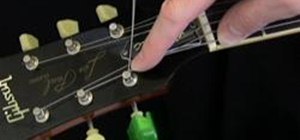There is a lot of mystery and voodoo surrounding blues guitar these days. With the common opinion claiming that in order to play the blues you have to really feel the music and respond with your playing. While this is certainly the case when improvising, I would argue that a good knowledge and understanding of the basic principles of blues guitar can provide even the beginner guitarist with a great sounding set of licks to impress friends and family.
In this article I will teach you a great lick for new guitarists eager to play the blues. I will also provide you with a little bit of the theory (the boring bit!) behind why it sounds so great. The lick itself is broken down into 3 steps and can be played as slowly as you want, so it's perfect for beginners. Just follow the steps below to learn to play it. I would recommend using the video at the bottom of this page and the article below together to get the most from this lesson.
Step 1 The first three notes
The first thing you need to do is place your fretting hand index finger on the 9th fret of the 3rd string (the G string or third thinnest) and pluck the string with your plectrum or finger/thumb to produce the 'E' note. You then place your middle finger on the 10th fret of the same string and pluck it again to produce the 'F' note, try and 'hold' this note for a little longer than the previous one (see video for guidance). Following this you place your ring finger on the 11th fret of the same string and pluck it to produce the 'F#' note. This should last about the same amount of time as the first note we played.
Tip
It is tempting during this step to simply slide your index finger up to each new note; however I would seriously recommend that you try and use each finger for each note as it makes the next step of the lick much easier and you will find that you will use the technique in loads of different situations.
Step 2 The second three notes
Now that you have (hopefully) learned that useful technique, we move onto the second section of the lick. For this we move our index finger over to the 2nd string (the B string or second thinnest) and the 10th fret. Pluck this to produce the 'A' note. If you want a bit of a challenge, after playing this note try to 'mute' the string and cut the note short, to achieve this simply lift your index finger while the note is ringing so that it only rests on the string instead of putting pressure on as you usually would. This effectively stops the noise dead in its tracks. Now we fret the same string at the 12th fret with our ring finger and pluck the string to produce the 'B' note. Next move back to the 10th fret of the same string with your index finger and pluck it again to get the 'A' note, hold the duration of this note so that it is about double that of the previous note.
Step 3 The final note and an additional challenge
The final step is the shortest but probably the most important. All we do is place our middle finger on the 11th fret of the G string again and pluck it to produce the 'F#' note. The duration of this note should be about the same as the last note we played. The importance of this step is not in the technical difficulty but in the theory of lead blues guitar. We have ended the small section of music (called a musical phrase) on the 'F#' note and not on 'B' – the scale in which we are playing! To end on the B note would have made the lick sound as if it were supposed to finish, and that nothing else would follow; ending on the 'F#' indicates to the listener that another lick is going to follow in order to finish the musical phrase. Try it yourself – play the lick that we have just learned twice but on the second time around, swap the finishing note from the 11th fret on the 3rd string to the 12th fret of the 2nd string. This means we are finishing on 'B' and because we are in the scale of B minor pentatonic it provides us with that finished sound. If you can't quite get your head around it then watch the video for an example.
As an additional challenge for more advanced beginners, see the video for a great 'response' lick that you can play after this one in order to start building the musical theme of a piece.
Just updated your iPhone? You'll find new emoji, enhanced security, podcast transcripts, Apple Cash virtual numbers, and other useful features. There are even new additions hidden within Safari. Find out what's new and changed on your iPhone with the iOS 17.4 update.
























Be the First to Comment
Share Your Thoughts